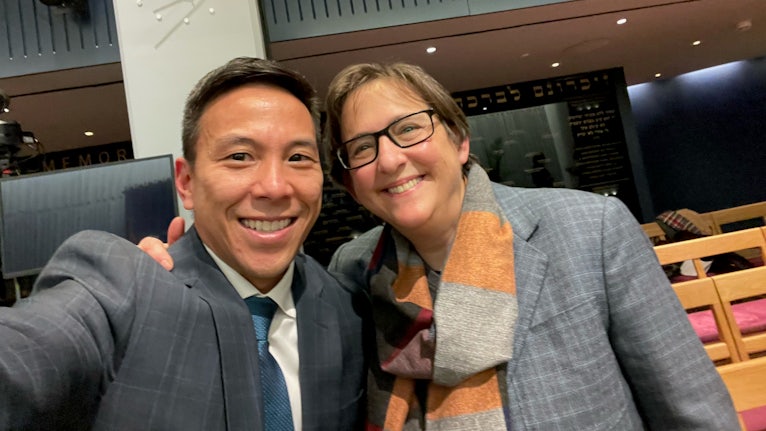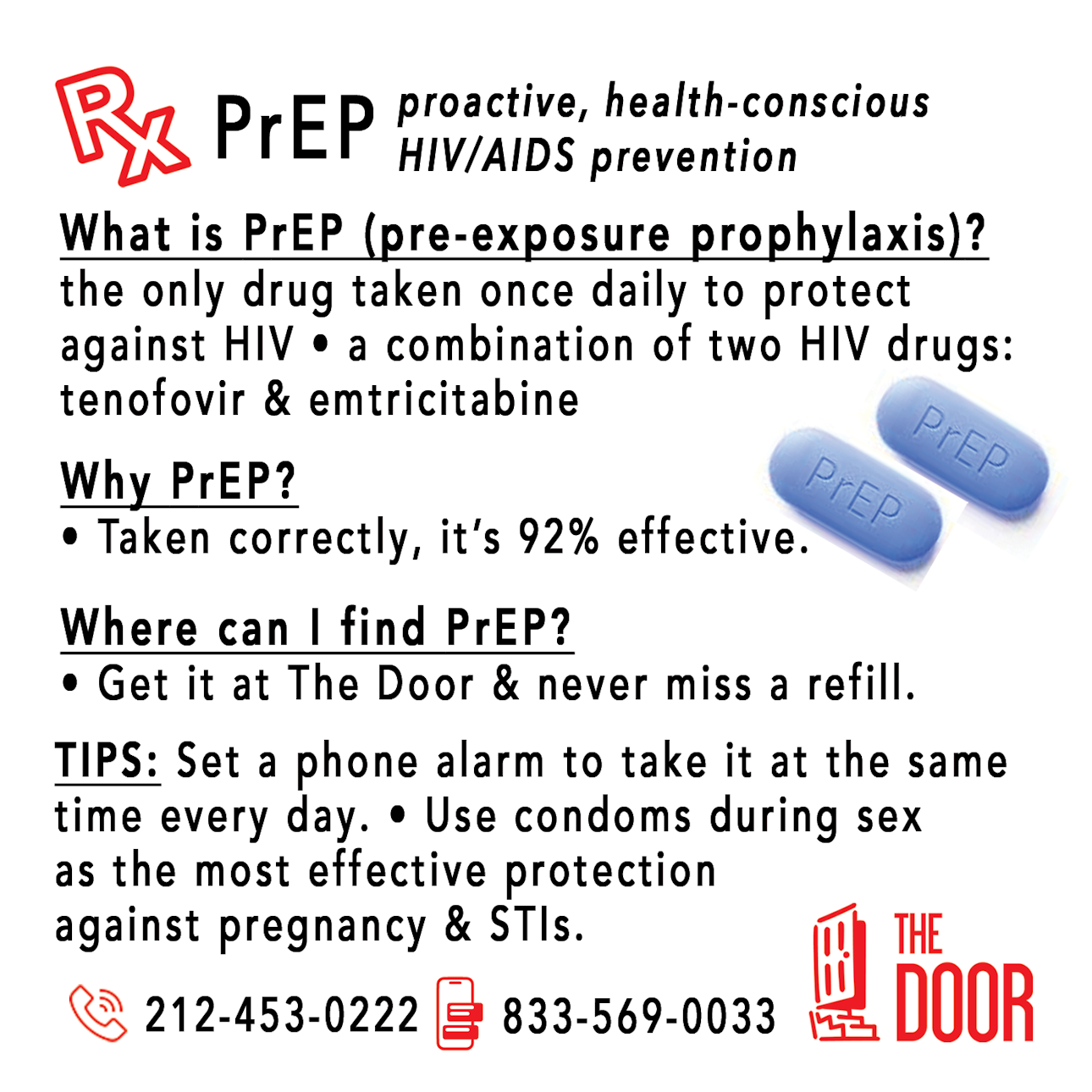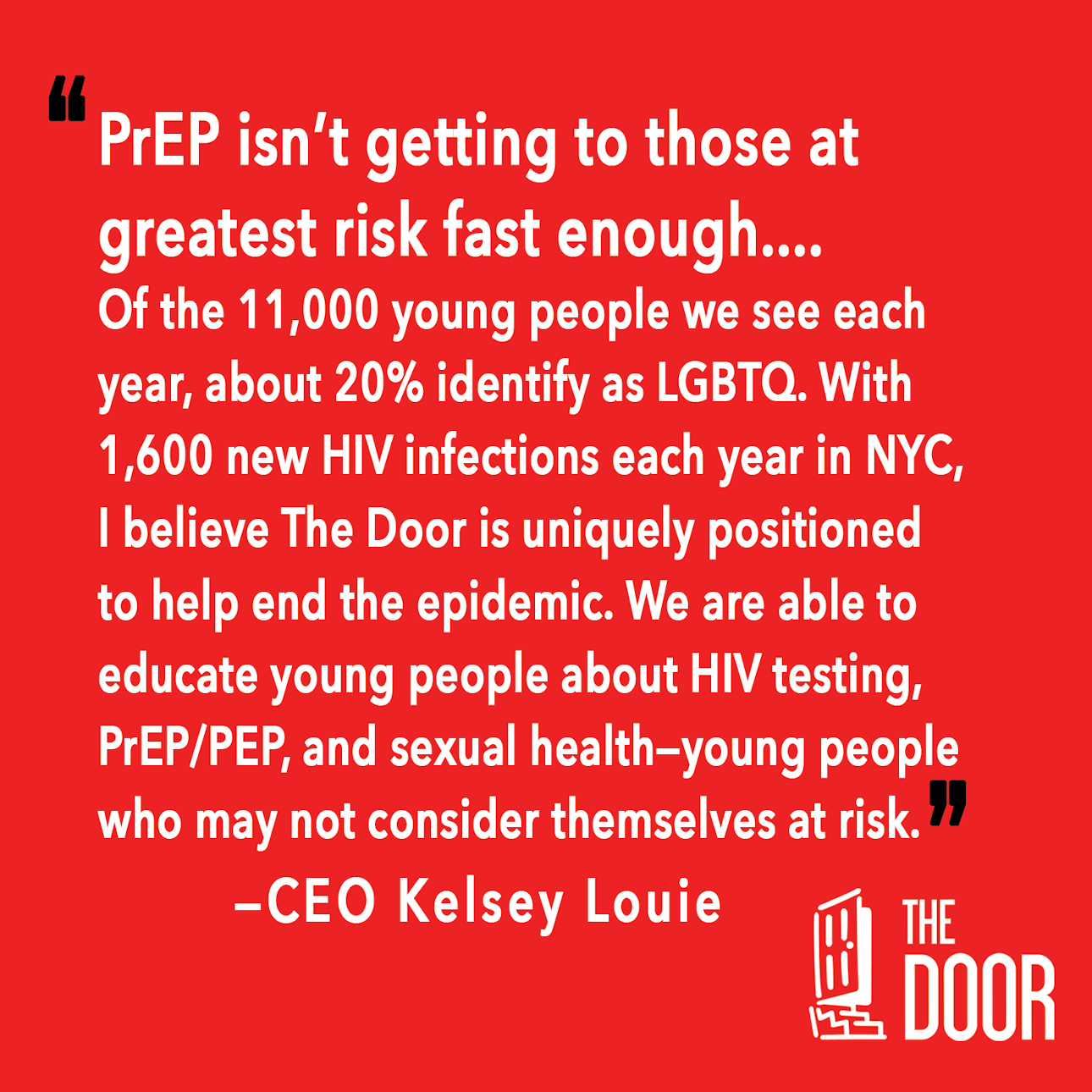
CEO Kelsey Louie at CBST World AIDS Day Shabbat
The Door was honored to have CEO Kelsey Louie mark World AIDS Day last week with Rabbi Sharon Kleinbaum and the congregation at Congregation Beit Simchat Torah (CBST), the world’s largest LGBTQ synagogue, for CBST’s World AIDS Day shabbat service. Based on his years of leadership in HIV- and youth-driven social services, Kelsey offered his unique perspective on where we are with HIV/AIDS today, ongoing health disparities, and what work is still needed.

Basics about PrEP (pre-exposure prophylaxis) as HIV prevention
In the context of New York’s commitment to health equity and the goal of ending the epidemic statewide by 2024, Kelsey particularly honed in on HIV testing, prevention, and barriers to care:
“Fifteen years ago, HIV prevention in pill forms—PrEP and PEP [pre-exposure prophylaxis and post-exposure prophylaxis]—didn’t exist. Those innovations have been a gamechanger, and ending the epidemic depends on getting more people on PrEP. But we can’t harness the power of PrEP or any other medical innovation when stigma, ignorance, or both stop people from getting tested, seeking treatment, and getting the help they need.”
You can read Kelsey’s complete remarks below. To learn more about The Door’s Adolescent Health Center, which offers free, confidential services for youth between the ages of 12 and 24, including primary care, sexual and reproductive care, and HIV prevention, visit door.org.

The Door CEO Kelsey Louie, talking about PrEP (pre-exposure prophylaxis) and HIV prevention
Where We Are With Ending AIDS
remarks by The Door CEO Kelsey Louie
Friday, December 2, 2022, CBST World AIDS Day Shabbat
Hello and shabbat shalom. My name is Kelsey Louie, and I am the proud CEO of The Door, a premier youth development organization. I am also a proud gay man and a proud former CEO of Gay Men’s Health Crisis, the world’s first HIV/AIDS service organization. I want to start by thanking Jay Fisher for inviting me here to speak about HIV and AIDS today.
In my years working in the HIV and AIDS field, I learned one thing time and again: We cannot do this work alone.
All of our progress over the 41 years of the AIDS epidemic has been the result of the strength and momentum we gain from working together, which is why speaking here tonight is so special to me. I would like to recognize how many people in this community have provided care for people living with HIV and AIDS—whether that’s through a job, a volunteer role, or activism, by caring for someone you love, or by raising money at AIDS Walk.
Every person’s engagement has ripple effects that make a huge difference. To find the embodiment of that kind of individual commitment and its impact, one doesn’t need to look any further than Jay’s mother Rita, who, with many of you, is the highest AIDS Walk fundraiser in GMHC’s history, having raised more than $1,000,000. Thank you, Rita, for all that you have done—I know that you are listening.
When COVID first came about, many people started to compare this new pandemic to the HIV/AIDS epidemic. Yes—there were a lot of similarities… poor communities and communities of color were hit much harder. Another, more important similarity is that communities showed up for one another. I saw firsthand how the HIV/AIDS community came together to support one each other. It recalled the darkest days of the epidemic, when AIDS was considered a death sentence that mostly affected gay men, and the government wasted years doing nothing. One of the most touching responses to AIDS within the community came from kind, powerful women of varied backgrounds, who stepped up to help, care for, and advocate for those at risk, for the newly diagnosed, the sick, and the dying when no one else would.
Similarly, when COVID hit, it didn’t matter that “coronavirus” wasn’t in an AIDS organization’s mission statement. Organizations like GMHC understand that deadly, infectious viruses with no cure, and the public health crises they cause, affect us all. We know that pandemics, epidemics, and other public health emergencies thrive on silence, information silos, discrimination, poverty, and other socioeconomic inequities. AIDS organizations knew the critical importance of raising awareness and disseminating factual information about how COVID is and is not transmitted, as well as combatting misinformation, stigma, and barriers to care. And when COVID vaccines became available, the discourse that took place—to ensure broad access and to prioritize populations at greatest risk—was inspiring…
As we shift into a more hybrid phase of the COVID pandemic, we’re seeing that whether it’s COVID, MPV, or HIV, the same drivers that turn infectious disease outbreaks into public-health emergencies are at play, and the work involved in battling those drivers remains the same.
On the up side, when we work together—when we create health policies driven by science and data, share critical resources equitably, break down stigma, and dismantle barriers to care, especially those caused by racism, homophobia, transphobia, and misogyny—we make amazing progress.
We’ve seen that kind of progress with COVID and MPV, and we still see it with what’s happening with HIV and AIDS today. Here are some highlights from the newest HIV surveillance data released by the NYC Department of Health for World AIDS Day yesterday [on December 1, 2022, World AIDS Day]:
From 2019 to 2021, the estimated number of new HIV infections in NYC decreased by 8%.
Likewise, new HIV diagnoses in NYC in 2021 is down 23% since 2017 and down 73% since 2001.
And even some of the not-great data news this week was a temporary anomaly that was expected:
In 2021, for the first time in years, NYC saw an atypical increase in the annual number of new HIV diagnoses—of 14%. However, that surge was anticipated as a COVID rebound. During the first waves of COVID in 2020, HIV testing and prevention services were less available and accessible. New HIV diagnoses dropped at a steeper rate as a result. In 2021, many sites re-opened and resumed HIV services. Simply put, it’s likely that people who delayed testing during early COVID waves tested in 2021 instead—hence the spike.
The real down side in HIV right now is the data that’s NOT an anomaly. This is stuff we’ve known for a long time. HIV continues to disproportionately affect Black and brown people, women, and LGBTQ people, especially LGBTQ people of color. Some salient 2021 data that reflects ongoing health disparities:
60% of all men newly diagnosed with HIV were men who have sex with men.
80% of all men newly diagnosed, were Black or Latinx.
88% of all women newly diagnosed with HIV, were Black or Latinx.
So, we still have more work to do. If anything, the heightened stigma around COVID and MPV have shown how the work that we’ve been doing for 41 years to fight HIV and AIDS is still so relevant today. Infectious disease thrives where it always has—in the shadows, under veils of shame and fear.
So, we still have more work to do. If anything, the heightened stigma around COVID and MPV have shown how the work that we’ve been doing for 41 years to fight HIV and AIDS is still so relevant today. Infectious disease thrives where it always has—in the shadows, under veils of shame and fear.
We still have work to do on the biomedical side—to find better, cheaper treatments, as well as a cure and a vaccine. But our biggest remaining battles in HIV/AIDS are combatting stigma, ignorance, and health disparities.
Fifteen years ago, HIV prevention in pill forms—PrEP and PEP—didn’t exist. Those innovations have been a gamechanger, and ending the epidemic depends on getting more people on PrEP. But we can’t harness the power of PrEP or any other medical innovation when stigma, ignorance, or both stop people from getting tested, seeking treatment, and getting the help they need.
Case in point: High cost, complex insurance coverage, and HIV medication hesitancy remain common barriers for PrEP. So PrEP usage is far lower than it needs to be—especially in the communities that need it most. PrEP isn’t getting to those at greatest risk fast enough.
All that needs to change.
My time at The Door has underscored that need. Of the 11,000 young people The Door sees each year, about 20% identify as LGBTQ. With 1,600 new HIV infections each year in NYC, I believe that The Door is uniquely positioned to help end the epidemic. We are able to educate young people about HIV testing, PrEP/PEP, and sexual health—young people who may not consider themselves at risk. A study done by Kaiser Permanente revealed that in 2019, more than 50% of people underestimated their risk level for HIV infection. If people don’t believe that they are at risk, then they won’t take the necessary precautions.
As always, the solutions are rooted in expanding access to every prevention and treatment tool we’ve got and building awareness and educating people about HIV, across all demographics. Young people especially. We have to find a way to get our messages to the people that need it the most, in the most accessible way possible.
So my biggest message to you tonight is that what we talk about matters. Because what we talk about becomes what we pay attention to and what we act on. The stories we share matter, at every level—whether that’s at the dinner table, among our friends and family, in our houses of worship, in our workplaces and the powerful halls of government, and in the media. The truth is, it wasn’t only about gay men in the 1980s, and it still isn’t. But people will only know that if we talk about it, disseminate good information, and share the powerful stories of the people who are affected by HIV and AIDS. After all, silence equals death.
That is our work. Our work is to transform science into policy, headlines into real resources, hope into commitment, and talk into action. Thank you for doing your part in that. Together, we will keep up the good fight, and we will end AIDS, once and for all.